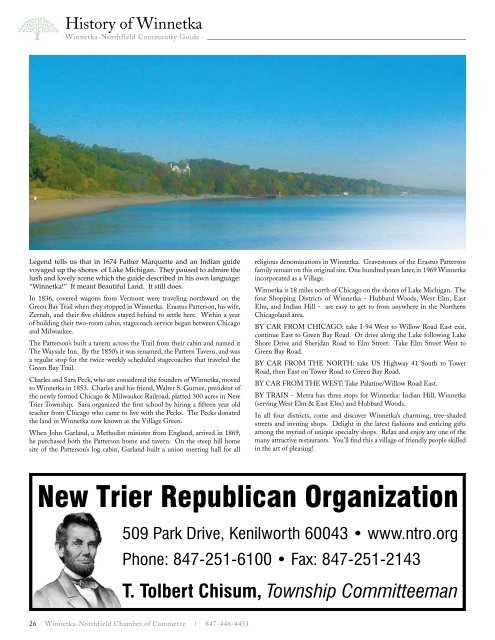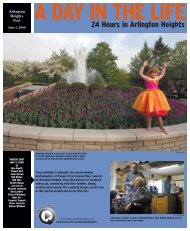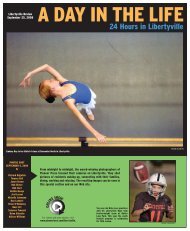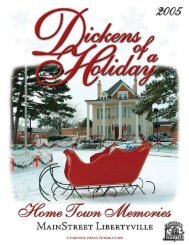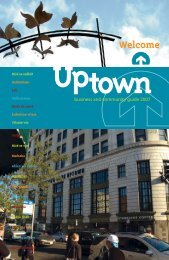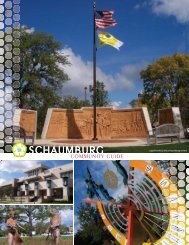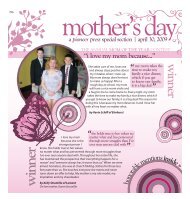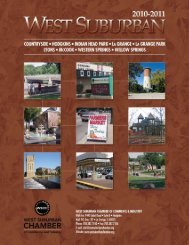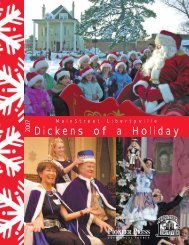2011 Winnetka-Northfield Community Guide - Communities
2011 Winnetka-Northfield Community Guide - Communities
2011 Winnetka-Northfield Community Guide - Communities
You also want an ePaper? Increase the reach of your titles
YUMPU automatically turns print PDFs into web optimized ePapers that Google loves.
History of <strong>Winnetka</strong><br />
<strong>Winnetka</strong>-<strong>Northfield</strong> <strong>Community</strong> <strong>Guide</strong><br />
Legend tells us that in 1674 Father Marquette and an Indian guide<br />
voyaged up the shores of Lake Michigan. They paused to admire the<br />
lush and lovely scene which the guide described in his own language:<br />
“<strong>Winnetka</strong>!” It meant Beautiful Land. It still does.<br />
In 1836, covered wagons from Vermont were traveling northward on the<br />
Green Bay Trail when they stopped in <strong>Winnetka</strong>. Erastus Patterson, his wife,<br />
Zernah, and their five children stayed behind to settle here. Within a year<br />
of building their two-room cabin, stagecoach service began between Chicago<br />
and Milwaukee.<br />
The Patterson’s built a tavern across the Trail from their cabin and named it<br />
The Wayside Inn. By the 1850’s it was renamed, the Pattern Tavern, and was<br />
a regular stop for the twice-weekly scheduled stagecoaches that traveled the<br />
Green Bay Trail.<br />
Charles and Sara Peck, who are considered the founders of <strong>Winnetka</strong>, moved<br />
to <strong>Winnetka</strong> in 1853. Charles and his friend, Walter S. Gurnee, president of<br />
the newly formed Chicago & Milwaukee Railroad, platted 300 acres in New<br />
Trier Township. Sara organized the first school by hiring a fifteen year old<br />
teacher from Chicago who came to live with the Pecks. The Pecks donated<br />
the land in <strong>Winnetka</strong> now known as the Village Green.<br />
When John Garland, a Methodist minister from England, arrived in 1869,<br />
he purchased both the Patterson home and tavern. On the steep hill home<br />
site of the Patterson’s log cabin, Garland built a union meeting hall for all<br />
religious denominations in <strong>Winnetka</strong>. Gravestones of the Erastus Patterson<br />
family remain on this original site. One hundred years later, in 1969 <strong>Winnetka</strong><br />
incorporated as a Village.<br />
<strong>Winnetka</strong> is 18 miles north of Chicago on the shores of Lake Michigan. The<br />
four Shopping Districts of <strong>Winnetka</strong> - Hubbard Woods, West Elm, East<br />
Elm, and Indian Hill - are easy to get to from anywhere in the Northern<br />
Chicagoland area.<br />
BY CAR FROM CHICAGO: take I-94 West to Willow Road East exit,<br />
continue East to Green Bay Road. Or drive along the Lake following Lake<br />
Shore Drive and Sheridan Road to Elm Street. Take Elm Street West to<br />
Green Bay Road.<br />
BY CAR FROM THE NORTH: take US Highway 41 South to Tower<br />
Road, then East on Tower Road to Green Bay Road.<br />
BY CAR FROM THE WEST: Take Palatine/Willow Road East.<br />
BY TRAIN - Metra has three stops for <strong>Winnetka</strong>: Indian Hill, <strong>Winnetka</strong><br />
(serving West Elm & East Elm) and Hubbard Woods.<br />
In all four districts, come and discover <strong>Winnetka</strong>’s charming, tree-shaded<br />
streets and inviting shops. Delight in the latest fashions and enticing gifts<br />
among the myriad of unique specialty shops. Relax and enjoy any one of the<br />
many attractive restaurants. You’ll find this a village of friendly people skilled<br />
in the art of pleasing!<br />
New Trier Republican Organization<br />
509 Park Drive, Kenilworth 60043 • www.ntro.org<br />
Phone: 847-251-6100 • Fax: 847-251-2143<br />
T. Tolbert Chisum, Township Committeeman<br />
<strong>Northfield</strong> was a remote swamp when settlers first arrived in the 1850s to<br />
farm. Residents of neighboring communities often called <strong>Northfield</strong>ers the<br />
“river folks” because they struggled to get to church or the beach in their<br />
wagons while crossing the Skokie Lagoons and the Middlefork of the north<br />
branch of the Chicago River.<br />
Early pioneer families included the Brachtendorf family, for whom Bracken<br />
Lane is named. They arrived in 1857, and their family home still stands at<br />
2264 Willow Rd. Dennis Donovan, who lived just east of the Brachtendorfs,<br />
arriving with his family in a coal wagon in 1855. Charles Metz came in 1861<br />
and settled where Somerset Lane is today. His family farmed on that land<br />
until the 1950s. John Happ, for whom Happ Road is named, was a blacksmith<br />
who came with his nine sons and daughter in the late 1850s. The arrival of the<br />
railroad in <strong>Winnetka</strong> in 1854 prompted him to close his blacksmith shop and<br />
move to <strong>Northfield</strong> to farm. Happ’s grandson John became <strong>Northfield</strong>’s first<br />
village president in 1926.<br />
During the last half of the nineteenth century, farm products included hay and<br />
grain, packing straw from the Skokie Swamps, mushrooms and horseradish.<br />
History of <strong>Northfield</strong><br />
<strong>Winnetka</strong>-<strong>Northfield</strong> <strong>Community</strong> <strong>Guide</strong><br />
In the early 1920s, the community changed dramatically when Samuel Insull,<br />
a powerful Chicago entrepreneur who headed the electric firm later named<br />
Commonwealth Edison, built the Skokie Valley Line of the North Shore<br />
Railway. He held a contest to name the village, which was incorporated in<br />
1926. The name Wau-Bun was chosen. Wau-Bun is an Indian word meaning<br />
dawn, which was also the name of a Wisconsin Indian Chief who camped<br />
in the area as part of the Pottawatomie tribe in the late 1700s. Locals always<br />
disliked the name. In 1927, Wau-Bun was formally dropped in favor of<br />
<strong>Northfield</strong>, which referred to the community’s location from Chicago.<br />
From this small beginning, the Village began to attract other north shore<br />
families who liked its small size and remote country atmosphere. Its population<br />
surged from 320 residents in 1930 to 4,887 in 1980, and today has grown to<br />
5,726 per a special census in 2006. A village hall was built at the intersection<br />
of Happ and Willow Roads in 1936 and was used for 31 years. A much larger<br />
facility is now located on the same site.<br />
26 <strong>Winnetka</strong>-<strong>Northfield</strong> Chamber of Commerce | 847-446-4451 www.winnetkachamber.com | www.northfieldchamber.org 27<br />
Botox®<br />
Fillers<br />
Facial Rejuvenation<br />
Rhinoplasty<br />
Body Contouring<br />
Mommy Makeover<br />
Minimally Invasive


